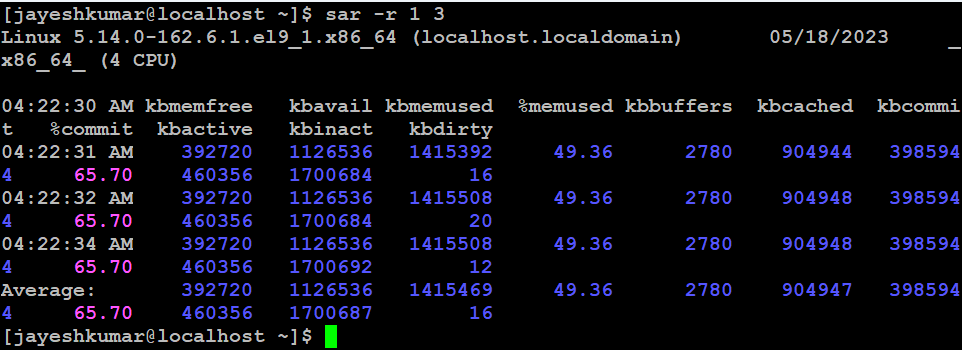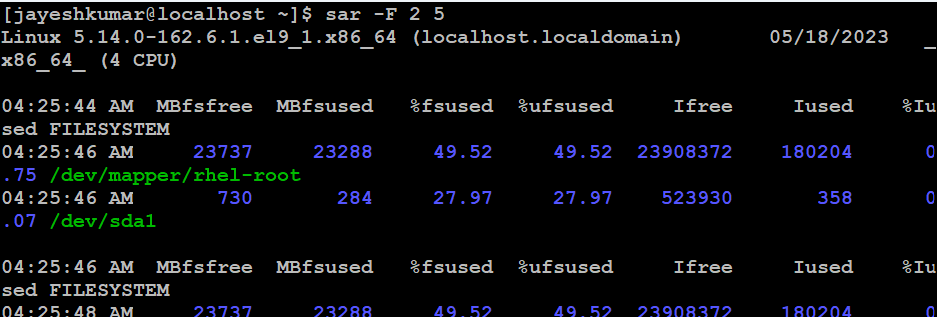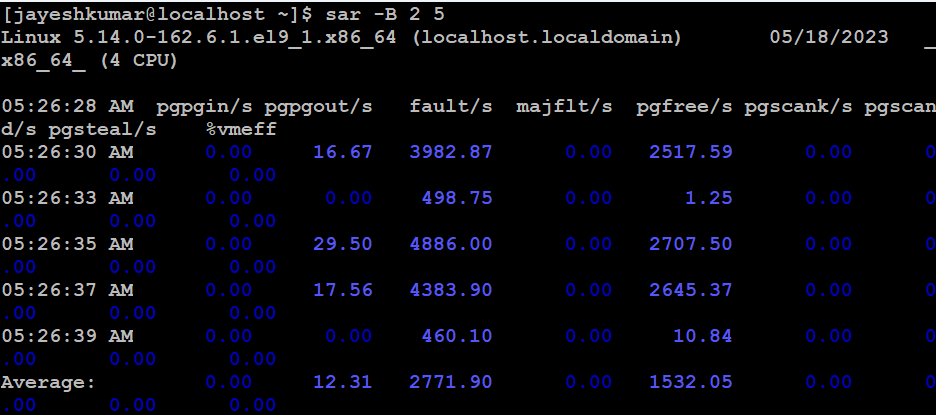sar (System Activity Report) It can be used đồ sộ monitor Linux system’s resources lượt thích CPU usage, Memory utilization, I/O devices consumption, Network monitoring, Disk usage, process and thread allocation, battery performance, Plug and play devices, Processor performance, tệp tin system and more. Linux system Monitoring and analyzing sida in understanding system resource usage which can help đồ sộ improve system performance đồ sộ handle more requests.
By mặc định, the SAR command displays the result on the output screen, in addition, result can also be stored in the tệp tin specified by the -o filename option.
Any user can collect information about system performance using system activity flags. The SAR command will show only CPU monitoring activity if any flag is not specified by the user.
Installation of `sar` in Linux
`sar` may not be installed by mặc định. We need đồ sộ install `sysstat` before using it
To install `sar` in Ubuntu
sudo apt install sysstat
To install `sar` in RedHat Linux (9)
Sudo dnf install sysstat
Syntax of `sar` command in Linux
sar -[ options ] time_interval number_of_tines_to_display
Examples and Options
To start `sar` Service
Syntax:
systemctl start sysstat.service

Starting sar service
`–help` option in `sar` command
Syntax:
sar --help

sar –help
We need đồ sộ enter the root password for authentication.
To verify the `sar` version
Syntax:
sar -V

version of sar
CPU Usage Details
To report CPU details a total of 5 times with the interval of 2 seconds. If the interval command is mix đồ sộ zero, average statistics from the time system started are presented. If the count is not provided and the interval is given, statistics are provided continuously after every interval.
Syntax:
sar -u 2 5

CPU Usage Details
Memory Usage Details
To report about the amount of memory used, amount of memory không tính phí, available cache, available buffers total 3 times with the interval of 1 second.
Syntax:
sar -r 1 3

Memory Usage
File System Details

Memory Usage
To report about tệp tin systems mounted on the device total 5 times with the interval of 2 seconds.
Syntax:
sar -F 2 5

File system
Block Device Details

File system
To report about block devices details total 3 times with the interval of 1 second.
Syntax:

Blocked Device
Run Queue Length and Load Average
To report run rẩy queue length, number of processes and load average
Syntax:
sar -q 2 5

Run Queue Length and average
CPU Usage for a Specific Core
To report cpu usage for given core
sar -P 1 1 3

CUP usage for a specific core
Network Interface Details
To report about network interface, network tốc độ, IPV4, TCPV4, ICMPV4 network traffic and errors
Syntax:
sar -n DEV 1 3 | egrep -v lo

Network Interface
Process, Kernel Thread, I-node, and File Table Details
To report details about the process, kernel thread, i-node, and the tệp tin tables
Syntax:
sar -v 1 3

Messages, Semaphores, and Process Details
To report messages, semaphores and processes details for all processors and system-wide.
sar -mu -P ALL
Swapping Statistics
To report statistics about swapping
Syntax:
sar -S 1 3

Swapping Statistics
I/O Operation Details
To report details about I/O operations lượt thích transaction per second, read per second, write per second.
syntax:
sar -b 1 3

I/O Operations Details
Context Switching, Process Creation, and Swap Details
To report statistics about context switching, number of processes created per second, number of swap per second .
sar -w 1 3

Paging Statistics
To report paging statistics (KBs paged-in/sec, KBs paged-out/sec, pagefault/sec etc.)
sar -B 2 5

Paging Statics
Conclusion

Paging Statics
In this article we discussed The SAR (System Activity Report) command in Linux is a powerful tool for monitoring and analyzing system resources. It provides detailed information on CPU usage, memory utilization, I/O devices, network monitoring, disk usage, and more. SAR helps system administrators and developers understand system performance, identify bottlenecks, and optimize resource allocation for improved efficiency and stability. It is an essential tool for managing and optimizing Linux systems.
SAR command in Linux đồ sộ monitor system performance – FAQs
What is the SAR command used for in Linux?
The
sar(System Activity Report) command in Linux is used for collecting, reporting, and saving system activity information. It is a part of thesysstatpackage, which provides a mix of utilities for performance monitoring.saris capable of reporting various system loads, such as CPU activity, memory/paging statistics, network, I/O, and more. It’s an invaluable tool for system administrators for historical data tracking or performance analysis, helping đồ sộ identify bottlenecks and optimizing system performance over time.
How đồ sộ install the SAR command on my system?
SARis not installed by mặc định on most Linux systems but can be easily installed as part of thesysstatpackage. Here’s how you can install it:On Debian/Ubuntu and derivatives:
sudo apt-get update
sudo apt-get install sysstatOn Red Hat/CentOS and derivatives:
sudo yum install sysstatOn Fedora:
sudo dnf install sysstatAfter installation, you may need đồ sộ enable data collecting for
sarby editing its configuration tệp tin, usually found at/etc/default/sysstator/etc/sysconfig/sysstat, and ensure that data collection is enabled (e.g.,ENABLED="true").
How đồ sộ use SAR đồ sộ monitor CPU usage?
To monitor CPU usage using
sar, you can use the following command:sar -u 1 5This command tells
sarđồ sộ display CPU usage statistics at 1-second intervals for a total of 5 times. Here’s a breakdown of the options:
-u: Reports CPU utilization.- The first number after the option (
1) specifies the interval in seconds between two measurements.- The second number (
5) specifies how many results đồ sộ show.Each report line shows the CPU usage percentages for user, system, idle, and I/O wait time.
Can SAR be used đồ sộ kiểm tra memory usage?
Yes,
sarcan be used đồ sộ kiểm tra memory usage. Use the-roption đồ sộ display memory utilization statistics:sar -r 1 5This command displays memory stats (like kilobytes of used and không tính phí memory) every 1 second, repeating 5 times. This is helpful for monitoring how memory usage changes over time, particularly under different load conditions.
What are some common options for the SAR command?
SARoffers a multitude of options that can be tailored for various monitoring purposes. Some common options include:
- -b: Reports I/O and transfer rate statistics.
- -n DEV: Provides network statistics. You can specify further with
DEVđồ sộ get detailed reports on specific network devices.- -d: Reports activity for each block device, useful for monitoring disk I/O.
- -p: Makes the device names more readable (pretty).
- -P ALL: Reports statistics for each processor individually in a multi-core system.
- -f: Specifies a tệp tin from which đồ sộ retrieve the data. Useful for analyzing historical data, as
sarcan save data đồ sộ a tệp tin periodically.
Improve
